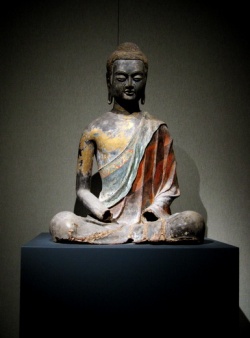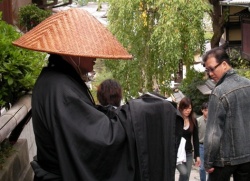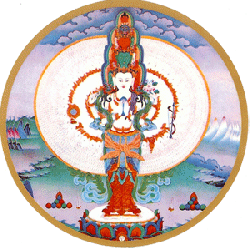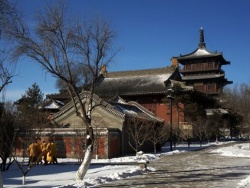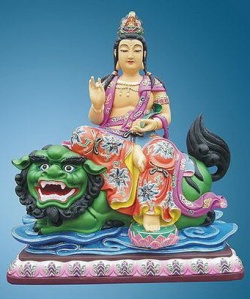Buddhist books of the dead
The Bon religion of Tibet and Tibetan Buddhism both maintain that crucial moments of transition are charged with great spiritual potential, especially the intervening moments between death and rebirth.
This intermediate period, called bardo, is a state of suspended reality in which the deceased are presented with a series of opportunities for recognition of the true nature of Reality. If the deceased persons are capable of recognizing the confusing and often frightening bardo visions as simply their own mental projections reflective of the previous life's thoughts and deeds (karma), the ongoing cycle of birth and death will be overcome.
Failure to recognize these appearances, on the other hand, leads eventually to rebirth and further suffering in cyclic existence (samsara).
To help the deceased travelers gain insight into their ambiguous situation, a spiritual teacher or lama recites inspirational prayers and instructions from special funeral texts - the first stage in the ritual of the Tibetan Books of the Dead.
The Tibetan Book of the Dead, which is more correctly referred to by its actual title, The Great Liberation upon Hearing in the Intermediate State (bar do thos grol chen mo), is traditionally regarded as the work of Padmasambhava, the eighth century founder of the Nyingma-pa Buddhist order and one of the first to bring Buddhism to Tibet.
Padmasambhava is believed to have hidden many of his esoteric teachings as literary "treasures" or terma (gter ma) in unusual and remote locations so that they would later be recovered at a time when their spiritual message would have the most beneficial impact. The remarkable people who discovered these sacred terma texts were identified as "treasure revealers" or tertöns (gter ston). Among the most famous of these discoverers of hidden teachings was Karma Lingpa (Kar ma gling pa, b.ca.1350), who is said to be the revealer of the so-called Tibetan Book of the Dead.
According to his biography, Karma Lingpa was born in southeast Tibet as the eldest son of the great Tantric practitioner Nyida Sangye (Nyi zla sangs rgyas). At an early age, he engaged in esoteric practices and was said to have achieved numerous yogic powers.
When he turned fifteen, Karma Lingpa discovered several hidden texts (terma) on top of Mount Gampodar.
From among these texts he found a collection of teachings entitled The Self-Emergence of the Peaceful and Wrathful Deities from Enlightened Awareness (zhi khro dgongs pa rang grol), which included the texts of the now famous Great Liberation upon Hearing in the Bardo.
The external omens are read by observing the condition of the body; the internal signs, by observing the breath and the individual's dreams; and the secret signs, by examining his or her bodily (and especially sexual) fluids.
To gain some idea of the nature of these often peculiar signs, we should mention just a few examples.
According to Karma Lingpa, if the discharge from a person's genitals is blackish or reversed, that is if blood comes from a man and semen from a woman, death will occur in one month.
If a person presses a finger against his or her eye and does not see light, cups his or her hand over the ears and does not hear a 'whirring' sound, or holds his or her arms out in front and they seem to disappear, these are all signs that the individual will die in less than four weeks.
Other such signs include suddenly encountering creatures with terrifying forms, experiencing bodily shivers, seeing stars during the day and sunlight at night, or seeing red flowers while riding backwards on a donkey in one's dreams.
These Deities manifest also in the same circular pattern of their peaceful counterparts, only now each Deity appears in its terrifying form.
As blood-drinking, flesh-eating demons, the Wrathful Deities symbolize the intensity or "violence," if you will, of liberation, understood here as the compassionate "murdering" of the neurotic and distorted thoughts and emotions that trap human beings in the ongoing cycle of rebirth.
Some more contemporary sources assert that the Deities, in both their quiescent and frightening forms, are not really gods in the traditional sense. They are actually symbolic manifestations of psychological states in the inner space of human awareness.
If the deceased is capable of properly identifying these Deities as projections of the mind and as manifest reflections of past karma, he or she will merge with the enlightened consciousness that these images represent.
Once again, however, if the visions are not recognized due to fear or ignorance, the deceased falls further into the bardo realms which lead eventually to a new existence.
Clearly, in the context of the Tibetan funeral rituals associated with this and other texts included in The Great Liberation upon Hearing, it is the prime responsibility of the religious specialist or 'lama' (bla ma) to gain the attention of the deceased and to make him or her aware of the visions encountered during the bardo experience.
Therefore, it is absolutely essential that the deceased gain outside assistance from a ritual expert or lama in order to receive the guidance necessary for insuring an auspicious rebirth within the six realms.
In addition to providing a descriptive map of the bardo experience, the Instructions to be Read Aloud on the Bardo of Becoming also outlines the ritual methods that the lama should employ during the latter half of the funeral ceremony.
According to these instructions, the lama must read the text out loud, correctly and distinctly, near the dead body. If for some reason the corpse is not present, the deceased's consciousness should be summoned by using a picture of him or her in the form of a blockprint or drawing on white paper.
This ritual image, called a jangbu (sbyang bu), must then be attached to a stick and placed on an altar in front of the lama.
During the ceremony, it is necessary that the deceased at all times be informed of, and guided through, the events of the Bardo of Becoming just as before, only now, the details of the lama's instructions emphasize the nature of the six realms of existence and are addressed directly to the blockprinted image sitting on the altar.
At the end of the ritual recitation, the lama takes the jangbu between his fingers, holds it over the flame of a butter lamp, and just as the fire consumes the image pronounces that the sins of the deceased have been absolved.
The consciousness of the deceased then departs from the flames on its way to the next life.
The "Prayer for Deliverance from the Narrow Paths of the Bardo" traces the series of experiences in the Bardo of Reality, requesting that the Peaceful and Wrathful Deities help the deceased to recognize the true nature of the bardo visions.
The "Prayer for Protection from Fear in the Bardo" is a general appeal to the Buddhas and Bodhisattvas for compassionate refuge from the fear and anxiety of death and transition.
Finally, "The Root Verses of the Six Bardos" encapsulates the essential instructions on the bardos which are included in the actual body of the bardo texts as poetic verses to be read by the lama to the dying person.
In his amazingly lucid and concise text, The Mirror of Mindfulness, Tse-le Natsok Rangdröl combines the wisdom of his own profound insight with that of the spiritual masters from whom he had learned so much to produce an instructional manual that anyone can utilize.
His commentary on the bardo states--together covering the whole cycle of living, dying, the after-death state, and rebirth - relates meditation and religious practice to the bardos in a way that can be easily applied to each practitioner's individual level of meditative skill.
The Mirror of Mindfulness, therefore, serves as a practical guidebook on how human beings, whatever their religious background, can best transform their lives and prepare for death by taking advantage of the opportunities that each bardo presents.
The Great Liberation upon Hearing:
The Signs and Omens of Death
Tibetan: Zab chos zhi khro dgongs pa rang grol las thos grol chen moâi skor: ÎChi ltas mtshan ma rang grol
Paro, Bhutan, 1976. I(Bhu)-Tib-82; 76-905033. [folios 131-155]
According to the literature associated with Karma Lingpa's Great Liberation upon Hearing, death occurs as a result of one of three causes: reaching the end of one's lifespan, exhausting one's meritorious energy, or meeting with an untimely event, such as a sudden accident.
Each of these three causes has its own specific antidote, which means that in many cases death can be avoided by applying the appropriate method.
Before applying such an antidote, however, it is necessary to know precisely when the death will occur. Knowledge of this sort requires skill in reading the signs indicating that death is near.
The small work entitled The Signs and Omens of Death is used for this very purpose. The text describes the variety of death omens in extensive detail, organizing them into three categories: external, internal, and secret signs.
The Great Liberation upon Hearing:
The Bardo of the Peaceful and Wrathful Deities
Tibetan: Zab chos zhi khro dgongs pa rang grol las thos grol chen moâi skor: [[Chos nyid bar doâi gsal Îdebs t
Paro, Bhutan, 1977. I(Bhu)-Tib-149; 79-902879. [text 2, 36 folios]
According to The Bardo of the Peaceful and Wrathful Deities, which is included in Karma Lingpa's Great Liberation upon Hearing, the final moment of the dying process is marked by the sudden and dramatic appearance of the radiant clear light.
As we saw in Section 2 above, the fundamental mind of clear light is said to exist beginninglessly and continuously in each individual through each lifetime and into Buddhahood itself.
For those Buddhist practitioners who became accomplished in the esoteric methods of yoga and meditation previously in their lifetimes, the true nature of the radiant clear light will be immediately recognized and the wisdom necessary for full liberation from the cycle of birth and death (samsara) will be achieved.
On the other hand, those who have not practiced during their lives will fail to recognize the clear light at death and will digress into the intermediate state known as the "Bardo of Reality" or Chö-nyi Bardo (chos nyid bar do), wherein the deceased experiences the visions of the one hundred Peaceful and Wrathful Deities.
In our text it is stated that seven days after the initial appearance of the radiant clear light of death, the deceased awakens in the bardo, confused and bewildered by a stunning array of lights and visions.
These colorful visions transform into the forty-two Peaceful Deities, who manifest in a circular pattern known as a mandala.
A mandala represents a perfectly contained sacred space, a celestial realm in which reside a great pantheon of enlightened spiritual beings. On the fourteenth day, this peaceful mandala dissolves into the mandala of the fifty-eight Wrathful Deities.
The Great Liberation upon Hearing:
Instructions to be Read Aloud on the Bardo of Becoming
Tibetan: Zab chos zhi khro dgongs pa rang grol las bar doâi gsal Îdebs thos grol chen mo bklag chog tu bkod pa Îkhrul snang rang grol)]: Srid pa bar doâi ngo sprod gsal Îdebs thos grol chen mo
1976. I(Bhu)-Tib-118; 77-902202. [folios 74a.4-94a.1]
Several days after the visions of the Peaceful and Wrathful Deities have subsided, the deceased acquires a mental body complete with all five senses, enters the "Bardo of Becoming" or Sipa Bardo (srid pa bar do), and begins his or her descent to a new birth.
Our text here from The Great Liberation upon Hearing entitled Instructions to be Read Aloud on the Bardo of Becoming details this third and final bardo state, in which the visions that now appear become increasingly associated with physical rebirth and culminate with the onset of prenatal experience.
The text relates that just prior to entering the womb at the instant of conception the bardo-being perceives its future parents in sexual embrace.
Being desirous, it rushes toward this vision, grows angry at either the mother or father (depending on whether it is to be born female or male), and in this emotionally agitated state makes the connection to its new life.
While in the Bardo of Becoming leading to the event of rebirth, the bardo-being experiences the manifestations of the previous life's accumulated karma and undergoes a series of disturbing sensations that create intense fear and confusion.
At this late stage, full liberation from samsara is practically unattainable and thus the deceased must strive to achieve a suitable rebirth in one of the six realms of existence--that of the gods, demi-gods, humans, animals, hungry ghosts, or hell-beings.
Ideally, the most favorable realm would be that of human beings, but actually to achieve this world is no easy task. In the bewildering state of the bardo, most beings usually have very little control over their behavior.
The Great Liberation upon Hearing: The Bardo Prayers
Tibetan: Zhi khro dgongs pa rang grol: Bar doâi smon lam
Kalimpong: Mani Dorji, 1979. 2 volumes. I-Tib-1990; 79-905078 [v2, folios 387-395]
The four devotional prayers and verses that constitute The Bardo Prayers express the very heart of the entire Great Liberation upon Hearing.
They are meant to be memorized by the lama and then recited as needed at certain keys points during the longer guidance ceremony.
The first, "Prayer Requesting Assistance from the Buddhas and Bodhisattvas," is a humble petition to all enlightened beings of compassion to reach out and comfort those who are dying or who are suffering in the intermediate state
The Mirror of Mindfulness:
A Clarification of the General Aspects of the Bardo Experience
Tibetan: Bar do spyiâi don thams cad rnam par gsal bar byed pa dran paâi me long
Author: rTse le sNa tshogs rang grol (b.1608)
Solu, Nepal, 1983. N-Tib-4294; 84-901065.
The Mirror of Mindfulness is a classic Tibetan text on bardo by Tse-le Natsok Rangdröl (rTse le sna tshogs rang grol, b.1608), a famous Tantric master of the Kagyu-pa order who was believed to be the incarnation of the eighth century translator Vairochana.
The notion of incarnation or tulku (sprul sku) is a distinctively Tibetan idea that after death an advanced spiritual personality will reincarnate in a form that is of special benefit to the people of a particular area.
Renowned as a tulku at an early age, Tse-le Natsok Rangdröl was favored by the people of his day as a religious virtuoso, and thus, was permitted to study with some of Tibet's most famous scholar-practitioners of the Kagyu and Nyingma sects
